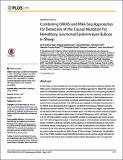Por favor, use este identificador para citar o enlazar a este item:
http://hdl.handle.net/10261/133379COMPARTIR / EXPORTAR:
 SHARE SHARE
 CORE
BASE CORE
BASE
|
|
| Visualizar otros formatos: MARC | Dublin Core | RDF | ORE | MODS | METS | DIDL | DATACITE | |

| Título: | Combining GWAS and RNA-Seq approaches for detection of the causal mutation for hereditary junctional epidermolysis bullosa in sheep |
Autor: | Suárez-Vega, Aroa; Gutiérrez Gil, Beatriz; Benavides, Julio CSIC ORCID ; Pérez Pérez, Valentín CSIC ORCID ; Tosser Klopp, G.; Klopp, Christophe; Keennel, Stephen J.; Arranz, Juan José | Palabras clave: | Aplasia-Cutis-Congenita Headed mutton sheep DNA-Sequencing data Pyloric atrasia Beta-4 integrin Gene Hemidesmosomes Missense Variants Horse |
Fecha de publicación: | 2015 | Editor: | Public Library of Science | Citación: | PLoS ONE 8: e0126416 (2015) | Resumen: | In this study, we demonstrate the use of a genome-wide association mapping together with RNA-seq in a reduced number of samples, as an efficient approach to detect the causal mutation for a Mendelian disease. Junctional epidermolysis bullosa is a recessive genodermatosis that manifests with neonatal mechanical fragility of the skin, blistering confined to the lamina lucida of the basement membrane and severe alteration of the hemidesmosomal junctions. In Spanish Churra sheep, junctional epidermolysis bullosa (JEB) has been detected in two commercial flocks. The JEB locus was mapped to Ovis aries chromosome 11 by GWAS and subsequently fine-mapped to an 868-kb homozygous segment using the identical-by-descent method. The ITGB4, which is located within this region, was identified as the best positional and functional candidate gene. The RNA-seq variant analysis enabled us to discover a 4-bp deletion within exon 33 of the ITGB4 gene (c.4412_4415del). The c.4412_4415del mutation causes a frameshift resulting in a premature stop codon at position 1472 of the integrin beta 4 protein. A functional analysis of this deletion revealed decreased levels of mRNA in JEB skin samples and the absence of integrin beta 4 labeling in immunohistochemical assays. Genotyping of c.4412_4415del showed perfect concordance with the recessive mode of the disease phenotype. Selection against this causal mutation will now be used to solve the problem of JEB in flocks of Churra sheep. Furthermore, the identification of the ITGB4 mutation means that affected sheep can be used as a large mammal animal model for the human form of epidermolysis bullosa with aplasia cutis. Our approach evidences that RNA-seq offers cost-effective alternative to identify variants in the species in which high resolution exome-sequencing is not straightforward. | Versión del editor: | http://dx.doi.org/10.1371/journal.pone.0126416 | URI: | http://hdl.handle.net/10261/133379 | DOI: | 10.1371/journal.pone.0126416 | ISSN: | 1932-6203 |
| Aparece en las colecciones: | (IGM) Artículos |
Ficheros en este ítem:
| Fichero | Descripción | Tamaño | Formato | |
|---|---|---|---|---|
| Suárez-Vega, A._ Combining GWAS_PloS One 2015.PDF | 11,14 MB | Adobe PDF |  Visualizar/Abrir |
CORE Recommender
PubMed Central
Citations
10
checked on 23-abr-2024
SCOPUSTM
Citations
14
checked on 24-abr-2024
WEB OF SCIENCETM
Citations
14
checked on 24-feb-2024
Page view(s)
322
checked on 23-abr-2024
Download(s)
276
checked on 23-abr-2024
Google ScholarTM
Check
Altmetric
Altmetric
Artículos relacionados:
NOTA: Los ítems de Digital.CSIC están protegidos por copyright, con todos los derechos reservados, a menos que se indique lo contrario.
